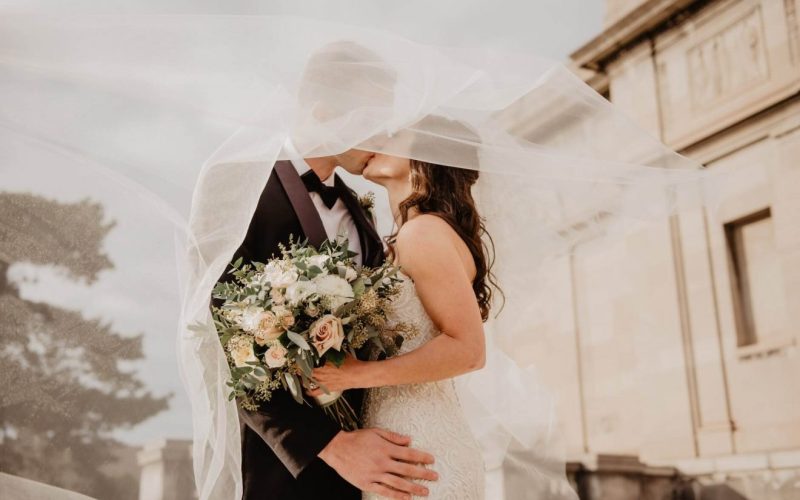The veil is the most important dress a woman will likely wear in her lifetime. However, modern brides already wear other alternatives.
But the veil remains the standard finishing touch of a wedding dress. The main intention of wearing a veil is to conceal the bride’s beauty.
People focus on the bride as she walks down the aisle, anticipating the removal of the veil. However, veils bring lots of anxiety because the bride gets confused about what veil to wear.
Read on as we discuss the different types of veils.
1. Chapel Length Wedding Veil
The first of the different types of veils is a chapel-length veil. It is a traditional full-length bridal veil that can stretch past the train on most wedding gowns.
People also refer to it as a church-length veil. Although chapel length is the most popular size of the designer’s long, floor-sweeping veils, it is not as long as cathedral wedding veils.
Brides frequently choose the chapel veil because they desire the illusion of a train without having one on their dress.
2. Waltz Veil
The Waltz veil is among the different types of veils available.
When the bride wears it, it is typically 54″ in length and falls between your knee and the ground when she is standing.
People also call them ballet veils or walking veils. They are simple to style and may be worn with any haircut.
This is the best option if you need a veil that falls between the calf and the ankle. Aside from that, they’re ideal for shooting those dramatic, windy photographs.
3. Birdcage Veil
A birdcage veil is a short veil with a comb on the head and conceals part of the face. Among the different types of veil, the birdcage veil is the most noticeable.
The comb to the edge of the material measures about 30-45cm. When paired with strong lip and vintage-inspired accessories, the birdcage veil will leave a lasting impression on your groom and guests.
Birdcage veils were particularly popular in the 1940s and 1950s, making them ideal for brides-to-be who want a retro bridal appearance or a vintage wedding.
Birdcage veils were particularly popular in the 1940s and 1950s, making them suitable for brides-to-be who want a retro bridal appearance or a vintage wedding.
4. Cathedral Veil
This is another type of long veil used in the bridal world. The cathedral veil is more common in formal weddings; it is very long and well-detailed.
It goes beyond the gown’s train and is ideal for wearing under or over a crown. People call it the cathedral veil because brides wear it mostly in cathedrals and churches.
However, brides should remember that the longer the veil, the harder it is for them to move conveniently. So, consider that before getting a cathedral veil because of the reception.
5. Fingertip Veil
A fingertip veil is a mid-length veil that a formal bride may wear. Many different fingertip veil designs exist, including modern, alternative, and traditional styles.
The term “fingertip length” refers to the length of the gown, which is approximately 36 inches long and extends to the bride’s fingertips.
Additionally, it looks stunning on any body type and is a fantastic match for most gown types.
It is the ideal length for a bride who wants a longer veil that isn’t too burdensome but yet wants to look elegant.
6. Blusher Veil
Among the different types of veils, a blusher veil is one. The bride wears it to hide her face until she is handed to the groom at the altar.
Brides wore blushers in the past to protect against evil. During arranged weddings, people used them to conceal the bride’s face to prevent the groom from seeing her before their wedding.
In recent years, blushers have evolved into more of a fashion item, serving as the finishing touch on a stunning bridal ensemble.
In addition to adding volume to an elegant updo, the blusher veil is both classic and contemporary.
7. Shoulder-Length Veil
When worn alone, shoulder-length veils are the shortest kind of veil, measuring only 20 inches in length for a single layer and 38 inches in total length for a two-layer version.
This veil is the right choice for those who want a more classic appearance to their veil. It also allows you to dance smoothly and without experiencing any difficulties.
Furthermore, it is a flirtatious alternative that will not overshadow or detract from your gown’s beauty.
8. Juliet Cap Veil
A Juliet cap is a little mesh with many beads, pearls, or diamonds. Brides typically wear this veil with evening gowns or as bridal apparel.
Juliet Capulet in “Romeo and Juliet” inspired this type of veil, which looks excellent with your hair down.
Juliet cap bridal veils are available in various lengths, from traditional cathedrals to flowy fairytale fingertip lengths.
Further, the Juliet cap is perfect for brides looking for a one-of-a-kind veil. It has delicate beadwork, lace edging, and elegant crystal finishing touches that will complement their gown while also reflecting their personality.
9. Elbow-Length Veil
This veil type is the last on our list of different veils, but that doesn’t make it any less good.
The elbow-length veil is perfect for drawing attention to details around your waist or complementing a hairdo you already have. It is also ideal for a bride who needs to cover her shoulders during the ceremony.
An elbow-length veil is 72cm from the comb to the end of the tulle or lace edge at the back of the head.
Conclusion
Every veil type is beautiful and elegant. But as a bride, you should note that not all veil types will match your dress or hairdo. So, all these have to be considered while choosing a bridal veil. Have a wonderful wedding!








